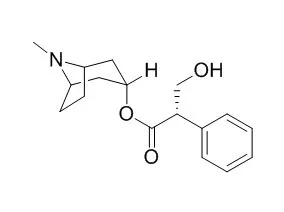| In vivo: |
| AJR Am J Roentgenol. 1993 Nov;161(5):965-8. | | Antispasmodic drugs to reduce discomfort and colonic spasm during barium enemas: comparison of oral hyoscyamine, i.v. glucagon, and no drug.[Pubmed: 8273637] | Parenterally administered glucagon is currently the agent of choice for reducing abdominal discomfort and colonic spasm during a barium enema. Because glucagon is expensive and frequently causes nausea, we evaluated the use of oral Hyoscyamine sulfate as an alternate agent and compared it with IV glucagon and no medication.
METHODS AND RESULTS:
A total of 349 adult patients undergoing barium enema examinations were randomly assigned in a prospective fashion to one of four groups: (1) no medication (87 patients); (2) 1 mg of IV glucagon (88 patients); (3) 0.125 mg of oral Hyoscyamine sulfate (87 patients); and (4) 0.25 mg of oral Hyoscyamine sulfate (87 patients). The degree of distension of the colon on radiographs obtained after fluoroscopy, the amount of abdominal distress after the procedure, and the number of side effects (nausea, palpitations, blurred vision, dry mouth) were analyzed. To evaluate the amount of abdominal discomfort more completely, we asked the last 248 patients to estimate the level of severity of the discomfort (none, mild, moderate, or severe).
We found no difference in the degree of distension of the colon in the four groups (p = .63). Most patients (79%) had some degree of abdominal discomfort. Fewer patients in the group who received no medication (10%) had no or mild pain compared with those given glucagon (15%, p < .05), 0.125 mg of Hyoscyamine (14%, p < .05), or 0.25 mg of Hyoscyamine (12%, p = .15). Less nausea occurred in the group that received 0.125 mg of Hyoscyamine than in the other groups (p < .03). No patients in any of the groups had allergic or severe side effects.
CONCLUSIONS:
When compared with IV glucagon, oral Hyoscyamine had fewer side effects, but the degree of colonic distension or abdominal distress was not significantly different. In addition, Hyoscyamine is considerably less expensive than glucagon and can be given orally. Patients who received medications had less discomfort than those who did not. However, the degree of distension was not different. | | J Community Support Oncol. 2015 Jan;13(1):3-7. | | Use of atropine-diphenoxylate compared with hyoscyamine to decrease rates of irinotecan-related cholinergic syndrome.[Pubmed: 25839059] | Cholinergic syndrome is a well established acute adverse reaction associated with irinotecan. Cholinergic side effects can be ameliorated or prevented with anticholinergic agents. To date, no formal studies have compared atropine-diphenoxylate and Hyoscyamine as premedications for prophylaxis of the cholinergic syndrome with irinotecan infusion.
To compare the incidence of cholinergic syndrome with irinotecan using atropine-diphenoxylate or Hyoscyamine as premedication.
METHODS AND RESULTS:
We conducted a retrospective, single-center, nonrandomized, cohort study of adult patients treated with atropine-diphenoxylate or Hyoscyamine as premedication before receiving irinotecan. For all irinotecan infusions, intravenous atropine was administered for patients experiencing any cholinergic reaction.
A total of 532 irinotecan cycles (354 cycles for atropine-diphenoxylate group; 178 cycles for Hyoscyamine group) were analyzed in 80 patients. Overall incidence of cholinergic syndrome did not differ between atropine-diphenoxylate (8.2%) and Hyoscyamine (9.0%) groups (P = .76). The incidence of cholinergic syndrome after the £rst cycle of irinotecan was similar between the 2 arms, atropine-diphenoxylate (14.6%) and Hyoscyamine (10.7%), with P = .74. The most common cholinergic symptoms documented were abdominal pain or cramping, and diarrhea.
This study was subjected to vulnerabilities to bias and random error because of its observational retrospective design and small number of participants.
CONCLUSIONS:
Lack of difference in the incidence of cholinergic syndrome observed in irinotecan-treated patients suggests atropinediphenoxylate and Hyoscyamine may both be effective prophylactic options. The findings support the need for a larger, randomized study to assess and compare these agents with other potential premedications such as scopolamine and atropine in prevention of irinotecan-related cholinergic syndrome. |
|






 Cell. 2018 Jan 11;172(1-2):249-261.e12. doi: 10.1016/j.cell.2017.12.019.IF=36.216(2019)
Cell. 2018 Jan 11;172(1-2):249-261.e12. doi: 10.1016/j.cell.2017.12.019.IF=36.216(2019) Cell Metab. 2020 Mar 3;31(3):534-548.e5. doi: 10.1016/j.cmet.2020.01.002.IF=22.415(2019)
Cell Metab. 2020 Mar 3;31(3):534-548.e5. doi: 10.1016/j.cmet.2020.01.002.IF=22.415(2019) Mol Cell. 2017 Nov 16;68(4):673-685.e6. doi: 10.1016/j.molcel.2017.10.022.IF=14.548(2019)
Mol Cell. 2017 Nov 16;68(4):673-685.e6. doi: 10.1016/j.molcel.2017.10.022.IF=14.548(2019)